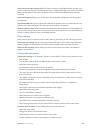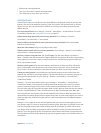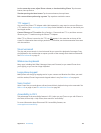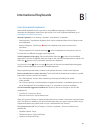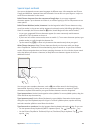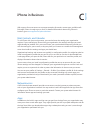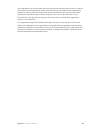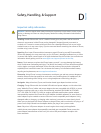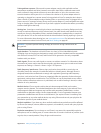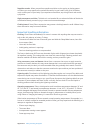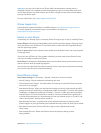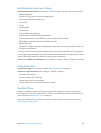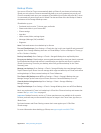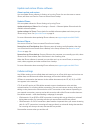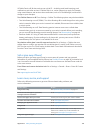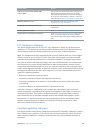
Appendix D Safety, Handling, & Support 152
Prolonged heat exposure iPhone and its power adapter comply with applicable surface
temperature standards and limits. However, even within these limits, sustained contact with
warm surfaces for long periods of time may cause discomfort or injury. Use common sense
to avoid situations where your skin is in contact with a device or its power adapter when it’s
operating or plugged into a power source for long periods of time. For example, don’t sleep or
place a device or power adapter under a blanket, pillow, or your body when it’s plugged into a
power source. It’s important to keep iPhone and its power adapter in a well-ventilated area when
using or charging them. Take special care if you have a physical condition that aects your ability
to detect heat against the body.
Hearing loss Listening to sound at high volumes may damage your hearing. Background noise,
as well as continued exposure to high volume levels, can make sounds seem quieter than they
actually are. Use only compatible receivers, earbuds, headphones, speakerphones, or earpieces
with your device. Turn on the audio and check the volume before inserting anything in your ear.
For more information about hearing loss, see www.apple.com/sound. For information about how
to set a maximum volume limit on iPhone, see Music settings on page 66.
WARNING: To prevent possible hearing damage, do not listen at high volume levels for
long periods.
Apple headsets The headsets sold with iPhone 4s or later in China (identiable by dark
insulating rings on the plug) are designed to comply with Chinese standards and are compatible
with iPhone 4s or later, iPad 2 or later, and iPod touch 5th generation. Use only compatible
headsets with your device.
Radio signals iPhone uses radio signals to connect to wireless networks. For information about
the amount of power used to transmit these signals, and about steps you can take to minimize
exposure, see Settings > General > About > Legal > RF Exposure.
Radio frequency interference Observe signs and notices that prohibit or restrict the use
of mobile phones (for example, in healthcare facilities or blasting areas). Although iPhone is
designed, tested, and manufactured to comply with regulations governing radio frequency
emissions, such emissions from iPhone can negatively aect the operation of other electronic
equipment, causing them to malfunction. Turn o iPhone or use Airplane Mode to turn o the
iPhone wireless transmitters when use is prohibited, such as while traveling in aircraft, or when
asked to do so by authorities.
Medical devices iPhone contains radios that emit electromagnetic elds, and contains
magnets near the bottom. The included headphones also have magnets in the earbuds. These
electromagnetic elds and magnets may interfere with pacemakers, debrillators, or other
medical devices. Maintain at least 6 inches (approximately 15 cm) of separation between your
pacemaker or debrillator and iPhone or the earbuds. If you suspect iPhone is interfering with
your pacemaker or any other medical device, stop using iPhone and consult your physician for
information specic to your medical device.
Medical conditions If you have any other medical condition that you believe could be aected
by iPhone (for example, seizures, blackouts, eyestrain, or headaches), consult with your physician
prior to using iPhone.
Explosive atmospheres Do not charge or use iPhone in any area with a potentially explosive
atmosphere, such as a fueling area, or in areas where the air contains chemicals or particles (such
as grain, dust, or metal powders). Obey all signs and instructions.



